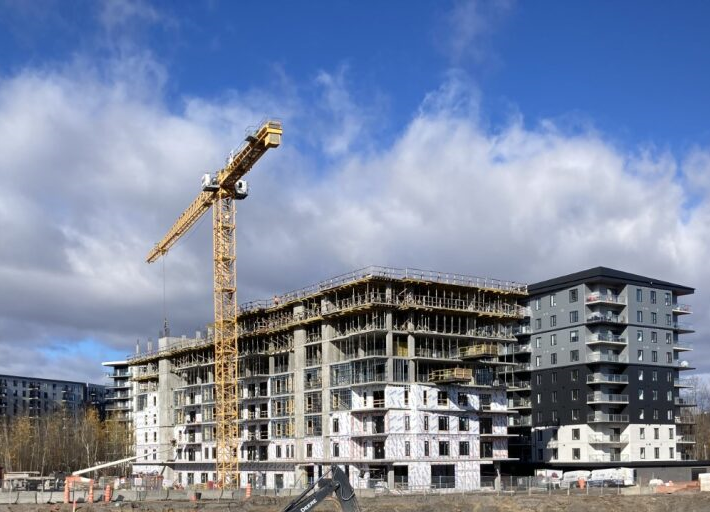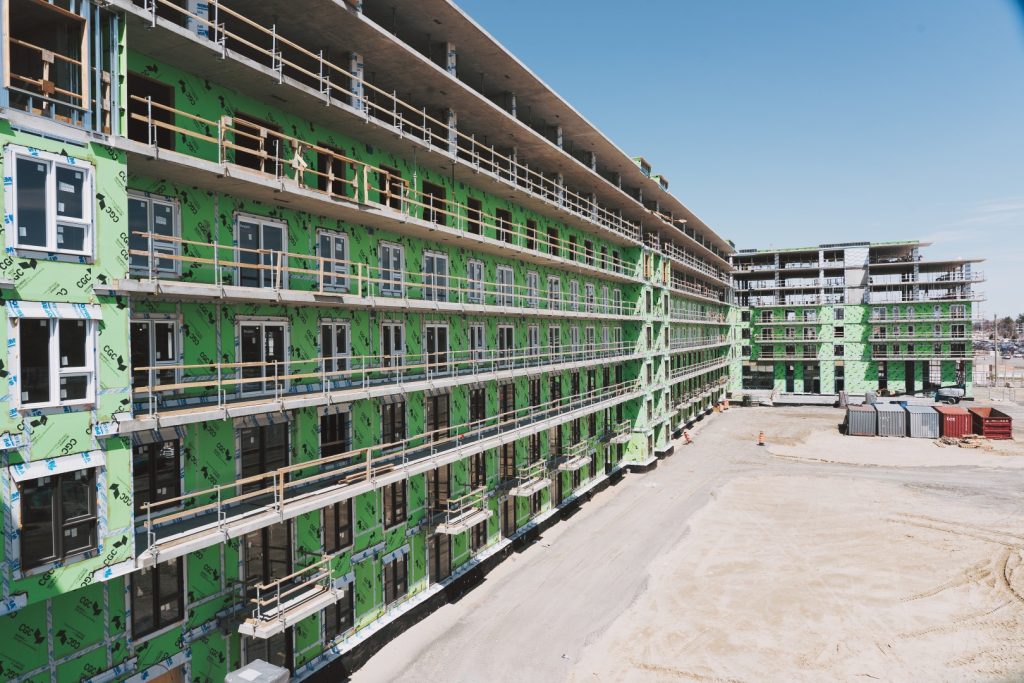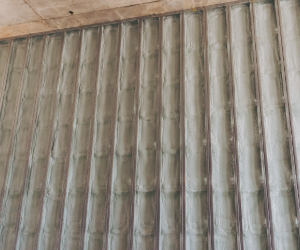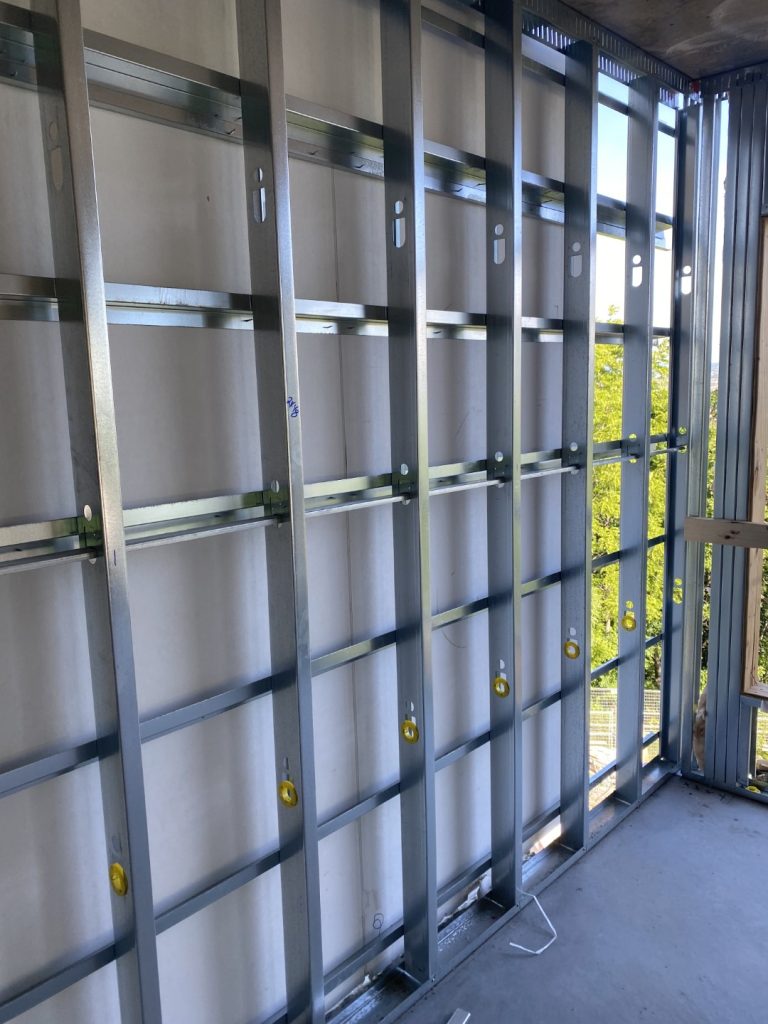
By Mickel Maalouf, LEED Green Associate and Sustainable Building Science Manager with Huntsman Building Solutions
In an increasingly carbon-conscious and performance-driven construction landscape, meeting regulatory compliance is no longer just about checking boxes, it’s about building smarter, faster, and more sustainably.
The 2020 update to Canada’s National Energy Code for Buildings (NECB) has redefined expectations on how building envelopes are designed and evaluated. With a heightened focus on air tightness, thermal performance, and overall energy efficiency, the Code is prompting developers, engineers, and architects to rethink traditional construction methods. The D-Max Wall Assembly addresses this challenge with a fully integrated, code-compliant solution that makes meeting regulations easier – while enabling the development of smarter, more sustainable, and higher-performing buildings.
Raising the bar for building envelopes
The NECB 2020 introduces new performance tiers and more stringent prescriptive requirements aimed at reducing energy consumption and greenhouse gas emissions in large buildings. Applicable to buildings over 600 square metres or more than three storeys in height, the updated code shifts focus on whole-building performance, including U-value calculations that account for thermal bridging and effective R-values.
While previous code iterations often relied on nominal R-values for compliance, NECB 2020 demands a more accurate understanding of thermal performance, placing emphasis on U-value which is the measure of thermal transmittance across an entire wall assembly, including junctions, fasteners, and penetrations.
The U-value provides a more accurate measure of real-world thermal performance by accounting for how heat escapes through an entire assembly, and not just insulation. It’s no longer sufficient to claim R-20 in the walls; developers, engineers, and architects must now demonstrate whole-assembly performance that considers structure, concrete slabs, brick ties, fasteners, and other thermal bridges that reduce energy efficiency.

Performance vs. prescriptive compliance
The NECB 2020 offers four compliance paths:
- Prescriptive path: Requires specific R-values for insulation materials; spray foam can easily meet or exceed these values, especially in space-constrained assemblies.
- Prescriptive with trade-offs path: Offers flexibility – if spray foam significantly improves thermal performance in one area (e.g., walls), it may allow trade-offs elsewhere (e.g., windows or roofs).
- Performance path: Emphasizes overall building energy use; spray foam’s air sealing and high thermal resistance can contribute to strong performance results in energy models.
- Tiered system path: Encourages builders to meet higher efficiency tiers. Spray foam’s ability to simplify meeting multiple performance criteria (e.g., airtightness, continuous insulation) positions it as a strategic choice for achieving upper tiers.
For example, the prescriptive path outlines specific maximum allowable U-values per component, with possible trade-offs to allow designers to trade off efficiencies across different systems (e.g., walls vs. windows). Meanwhile, the performance path requires whole-building energy modeling to demonstrate that the proposed building would require no more energy to operate than an equivalent prescriptively designed building. Either way, thermal bridging must be addressed.
To support accurate modeling, Huntsman Building Solutions partnered with external consultants to test and calibrate D-Max Wall in accordance with ASTM C1363 and computational modeling in accordance with ASHRAE 1365-RP. The results are clear: even when accounting for mechanical fasteners and complex junctions, D-Max Wall assembly offers many options to outperform code minimums across Canadian climate zones.

The D-Max Wall: An integrated envelope solution
The D-Max Wall assembly is Huntsman Building Solutions’ engineered response to NECB 2020 challenges. This innovative solution integrates insulation, air barrier, vapour barrier, and structural detailing into a streamlined system that meets or exceeds all major performance requirements, such as thermal, air, water, and fire resistance, without unnecessary complexity or material redundancy.
Some of its key features include:
Interior insulation strategy: D-Max Wall assembly allows full insulation from the interior, simplifying installation schedules and reducing weather-related delays.
Variable Z-Girt depths: These create continuous insulation cavities filled with Huntsman Building Solutions’ Heatlok Soya HP spray foam, minimizing thermal bridging.
Spray foam efficiency: Heatlok Soya HP, Huntsman Building Solutions’ all-in-one spray foam (insulation, air barrier, and vapor barrier) offers an industry-leading R-6 per inch, tested and validated for long-term performance.
Durability: Assembly tests confirm that D-Max Wall maintains air and water tightness even after extreme wind loads and year-long environmental exposure.
Fire resistance: Certified under CAN/ULC S101 and S134 standards, the D-Max Wall meets code requirements for use in non-combustible construction and high-rise applications.
Tested to perform: Now and in the future
Air barrier performance and resilience is a major part of NECB 2020 compliance. To this end, Huntsman Building Solutions subjected its D-Max Wall assemblies to rigorous testing per CAN/ULC S742 and ASTM E331. Assemblies were built to replicate real-world complexity, including foundation transitions, mechanical penetrations, a concrete slab detail, and window junctions without relying on transition membranes.
Testing revealed:
- Air leakage rates well below the 0.05 L/s·m² @75 Pa threshold.
- High wind pressure resistance up to 3820 Pa.
- Water penetration resistance up to 300 Pa.
- Long-term durability, confirmed by re-testing after one year of real-world outdoor exposure.
Unlike traditional batt or board stock insulation, spray foam provides a continuous, seamless seal that retains its properties over decades, reducing long-term energy loss and minimizing risk of mold, air infiltration, or degradation.

Sustainable, scalable, and future-ready
From an environmental standpoint, Heatlok Soya HP spray foam insulation exemplifies the future of low-impact construction. Using an HFO blowing agent with a Global Warming Potential (GWP) of just 1, which gives the product an 80 per cent reduction in an embodied carbon compared to previous HFC-based spray foams, this product stands out as a best-in-class solution for green building.
In fact, Heatlok Soya HP spray foam insulation has a lower carbon footprint than mineral wool and fiberglass insulation, especially when lifecycle emissions are considered.
Construction-ready with real-world ROI
With widespread availability and compatibility across structural systems, the D-Max Wall assembly isn’t just a high-performance wall, it’s a construction strategy. Many builders using D-Max Wall have saved three to five weeks on installation schedules, due to the ability to insulate floors before cladding is complete and continue work regardless of weather.
Furthermore, because all insulation is installed from inside the building, cladding and insulation can proceed simultaneously, streamlining trade coordination and reducing general conditions costs.
Conclusion: Meeting code is just the beginning
As Canadian provinces move to adopt NECB 2020, building professionals will face increasing pressure to improve envelope performance, reduce emissions, and deliver long-lasting, energy-efficient structures. D-Max Wall assembly is more than a code-compliant system, it is a pathway to performance, efficiency, and sustainability.

About Mickel Maalouf
Mickel Maalouf is a LEED Green Associate and Sustainable Building Science manager with Huntsman Building Solutions.

About Huntsman Building Solutions
The Huntsman Building Solutions business is a global leader in high-performance, sustainable building envelope solutions. Its systems and solutions are widely utilized to optimize commercial and residential structures worldwide in both new construction and retrofit applications.
Formed in 2020 with the acquisition of Icynene-Lapolla and its combination with Demilec, the Huntsman Building Solutions business capitalizes on legacy industry technologies, environmental stewardship, and the power of the Huntsman brand.
For more information, visit huntsmanbuildingsolutions.com.


Leave a Reply